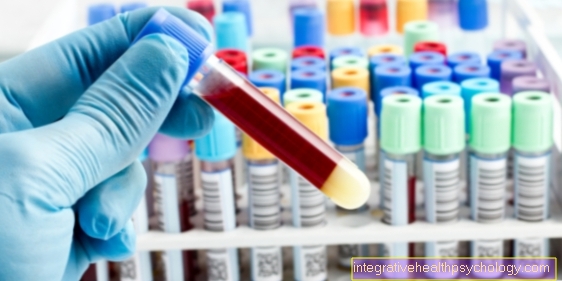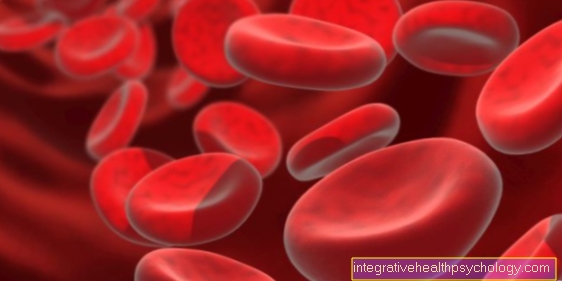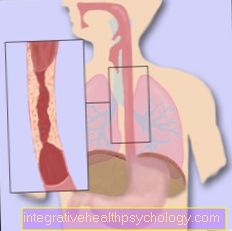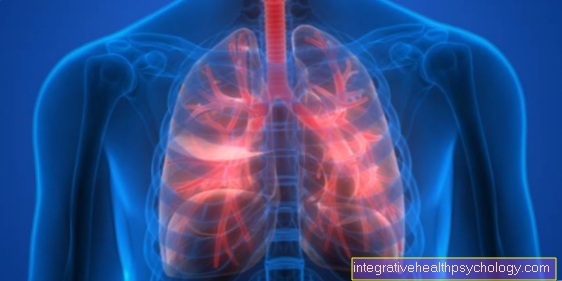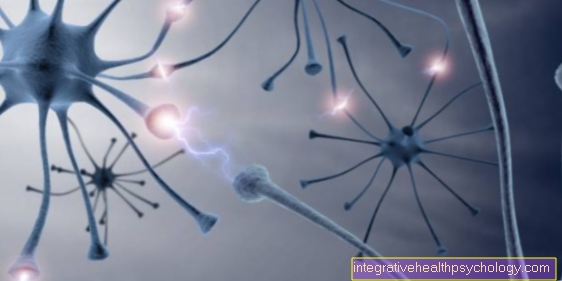Alcohol poisoning
Introduction / definition

According to the Federal Statistical Office, over 100,000 people are treated for alcohol poisoning in hospitals in Germany every year. The age group between 15 and 20 years is particularly badly affected. With around 20,000 cases (2007), it accounts for the largest proportion of alcohol poisoning. But the age group between 10 and 15 years is also well represented with almost 3000 cases annually, which shows that alcohol is also relatively popular with children. While alcohol poisoning in children between 10 and 15 years has remained relatively constant over the last 10 years, the number of cases in the 15-20 age group increased by almost 50% from 13,000 to 20,000.
Alcohol poisoning is not clearly defined because different blood alcohol levels in patients can have different effects. One subdivides much more into four stages, which depend on the symptoms. The first stage describes excitation, i.e. arousal, and manifests itself through symptoms such as increased talkativeness, disinhibition and imbalance (from about 0.8 per thousand). Almost everyone has been at this stage, it is defined by a blood alcohol concentration between 0.2 and 2.0 per thousand. The body itself is able to break down about 0.1 to 0.2 per thousand per hour.
This is followed by the second stage, or hypnosis stage, from 2.0 to 2.5. Symptoms of this are vomiting, memory loss, visual and movement disorders, and possibly aggressiveness. In the third stage, the anesthetic stage, there is unconsciousness and shock - the first signs of a serious, life-threatening situation. The stage of anesthesia is defined from a blood alcohol concentration of 2.5 to 4.0 per mille.
Read more about this under Memory loss.
Alcohol poisoning with values above 4.0 per mil is usually fatal. Death usually occurs due to circulatory failure and respiratory arrest. The alcohol has a paralyzing effect on the muscles, so that the important heart and respiratory muscles no longer work. It is not for nothing that stage 4 is also called the asphyxia stage, or the “stage of lack of pulse”. In individual cases, blood alcohol levels above 4 per thousand cannot be fatal, but this is usually the case with long-term alcoholics or habitual drinkers. Occasional cases of patients with 10 or more per mille are known. However, these are absolute exceptions - blood alcohol concentrations in the double-digit range are very likely to be fatal even for "hard-drinking" people.
Synonyms for alcohol poisoning are “alcohol intoxication” - “alkintox” for short, or C2 abuse, which is derived from the structural formula of ethanol - C2H5OH. In the rescue service, therefore - a little bit encrypted - is spoken of a "C2-ler".
Are you interested in how psychologists would classify your personal alcohol consumption? Just carry out our alcohol consumption self-test!
Causes of Alcohol Poisoning
After the alcohol has been ingested orally, a good 20% of it is absorbed in the stomach, the remaining 80% in the subsequent small intestine. Alcohol is the slang term for ethanol.
There are many different alcohols, which can always be identified by the -OH compound in the empirical formula. However, only ethanol is the classic "drinking alcohol". For example, methanol is also an alcohol, but excessive consumption leads to blindness. The drinking alcohol "ethanol" is absorbed through the lining of the stomach and small intestine, and thus enters the bloodstream. Eating high-fat food before consuming alcohol makes absorption difficult, but does not prevent it. So there is only a delayed, slower recording.
On the other hand, warmth like in fire tongs punch and carbon dioxide like in Prosecco accelerate the absorption of alcohol, since the blood circulation of the digestive tract is stimulated and accelerated. Once the alcohol has entered the bloodstream, it is metabolized in the liver. From an anatomical point of view, the liver is upstream of the heart within the bloodstream and filters foreign matter from the blood. To do this, she uses various enzymes: alcohol is first broken down into ethanal by alcohol dehydrogenase. Ethanal to acetic acid by another enzyme. Acetic acid is then distributed throughout the body for energy.
The cause of the typical "hangover symptoms" such as nausea and vomiting is the ethanal, which first has to be broken down slowly. By the way, the breakdown is inhibited by sugar, so that sugary drinks such as mulled wine or cocktails cause a particularly strong hangover.
More on the topic here: Hangover after alcohol- what to do?
Ethanol causes a wide variety of harmful physical effects. Almost all organs and compartments of the body are affected. The cause of a fatal outcome of alcohol intoxication is usually a combination of paralysis of the respiratory muscles and the respiratory center in the brain, such as paralysis of the heart muscles. As alcohol dilates the blood vessels, there is a sensation of warmth in advanced stages. Peripheral blood vessels are also dilated, so that the core body temperature falls. From below 32 degrees body temperature, a so-called cold idiocy occurs, in which the patient continues to undress due to subjective feeling of warmth. Sometimes the greatest danger of alcohol poisoning is therefore the patient's hypothermia, or “hypothermia” for short.
In addition, in the unconscious stage, vomiting can cause suffocation. When the swallowing muscles relax, vomit can flow from the esophagus through the throat into the windpipe. There it obstructs the airways and the patient suffocates. It is therefore important to lay the unconscious in the stable side position. In principle, the aim is to bring the stomach higher than the mouth in terms of its position. In extreme terms: you could hang an unconscious person upside down on a tree by their feet, the risk of aspiration would be zero. However, this would probably not contribute to the cooperation of the patient when he wakes up again.
also read: Alcohol intolerance
Symptoms / signs
There is no clear definition of the alcohol level above which one can speak of alcohol poisoning. Much more you focus on symptoms such as unconsciousness or respiratory failure. In principle, one speaks of alcohol poisoning for every patient who has been admitted to the hospital for alcohol consumption. This is usually the case when relatives or friends are worried that the person is unconscious and call the emergency services. In addition to unconsciousness, hypothermia and - with very high alcohol levels - breathing and pulse irregularities can occur. This is an absolute indication for inpatient care in the hospital as it is a sign of a potentially fatal state of consciousness.
Symptoms that can occur before alcohol intoxication, but are not fatal on their own, are vomiting, headaches, rapid heartbeat, unsteady gait, insecurity of speech, memory loss (“film tear”), aggressiveness and disinhibition. The next day vomiting, headache, dizziness, sensitivity to noise and light as well as blurred vision and diarrhea occur. The headache is based on an expansion of the blood vessels in the brain, which then press on the surrounding structures. The racing heart after alcohol can have various causes. Stomach pain and heartburn are the result of increased acid production in the stomach. In addition, the body is dehydrated because alcohol causes increased urine excretion because it inhibits the excretion of a hormone ("antidiuretic hormone") that is important for urine concentration in the brain.
Since in the intoxication against the thirst usually no water but more alcohol is consumed, a vicious circle develops. The alcohol also inhibits water absorption in the small intestine, which in addition to dehydration also leads to diarrhea. In very bad cases, Imodium can be taken against diarrhea, but since it is a short-term phenomenon that is usually over after a day, an intake should be carefully considered. In order to alleviate the symptoms, it is of course advisable first and foremost to know your limit and to stop drinking at a certain point. If this is no longer possible, attempts must be made to remove or dilute the alcohol from the body if possible.
Read more about the topic here: Alcohol - effect on the various organs
therapy
Acute alcohol poisoning is usually monitored in the hospital in an intensive care unit. Since they can be potentially fatal, one is special intense Supervision necessary. If you last consumed alcohol only a few minutes ago, you can do so in the first instance the stomach pumped out to prevent further alcohol intake. If high blood alcohol levels of over 4 per mille have already been reached, a emergency dialysis - thus blood washing - are initiated.
The blood is pumped out of the patient, outside the body in a centrifuge cleaned, and then returned to the patient. Such procedures are usually reserved for patients with end-stage kidney failure. To alleviate the effects the next day, a Saline solution to rehydrate the body, and increase the alcohol level in the blood dilute. In case of deep unconsciousness, patients must also be in the stable side position stored to prevent aspiration with vomit. In the best case, the latter ends with pneumonia, in the worst case with death. Are suitable for self-therapy self-induced vomiting, fresh air, and much water. The aim is to remove or dilute the alcohol from the body as quickly as possible.
If you find an “alcoholic oak” at a party in the evening, many people wonder what they can do now: First of all, the alcoholic should addressed loudly and possibly a Pain stimulus be set. This can be done, for example, by rubbing the Sternum respectively. If there is no response, a promotion to the stable side position as well as the understanding of the Ambulance service to be undertaken. Until the arrival of the rescue service, the drunkard should observed become.
Vomiting manifests itself in alcohol poisoning with unconsciousness "unfortunately" Not as usual with loud choking noises: Much more the vomit flows slowly out of the mouth and is only noticed when the patient gasping for air reflexivelybecause the airways are blocked. For laypersons and first aiders, the following applies at this point: The only mistake that can be made is nothing to be done, because then the person affected will die with a high degree of certainty. The goal is that Vomit from the trachea and esophagus to flow out of the mouth. To do this, the body and the head are placed as low as possible in order to natural gradient to create. A pat on the back can speed the flow. However, because of the risk to yourself, you should refrain from putting your hand or finger in the mouth of the person concerned.
The patient's heat retention is also important, as they are no longer able to do this themselves. It should be noted that even outside temperatures of 30 degrees are still 7 degrees below the physiological body temperature and can therefore cause severe hypothermia.
Alcohol in children
Alcohol has one in children much stronger effect than in adults. One reason for this is that children less used to alcohol are, on the other hand, that you weigh a lot less and a lot smaller blood volume and alcohol breakdown depends, among other things, on body weight. What an adult does not even feel can cause alcohol poisoning in children. Since alcohol poisoning in children can be fatal much faster, is one Immediate presentation to the hospital necessary - even with small amounts of alcohol that adults would consider null and void. Alcohol can be too in children permanent brain damage to lead.
Alcohol is also teratogenic, that is, it damages the embryo if it is ingested during pregnancy. Long-term effects of excessive alcohol consumption during pregnancy are typical Microcephaly (small head), mental retardation, short stature, speech and hearing disorders, skeletal malformations such as Funnel breast and Spinal curvature. Furthermore, poor concentration, hyperactivity, aggressiveness, slowing down, low tolerance for frustration and quick distraction, to name just a few. In summary one speaks of a fetal alcohol syndrome. The exact signs depend on the month of pregnancy in which the most alcohol was consumed. Alcohol consumption in the second trimester (4th-6th month) are most likely to lead to a miscarriage. Children carry lifelong consequential damage, which nothing can be done about postnatally. This makes it all the more important to abstain from alcohol and nicotine during pregnancy.


